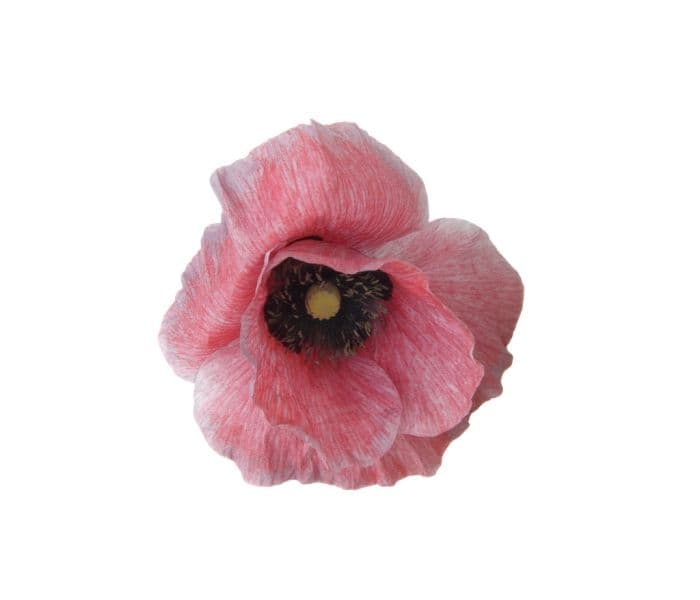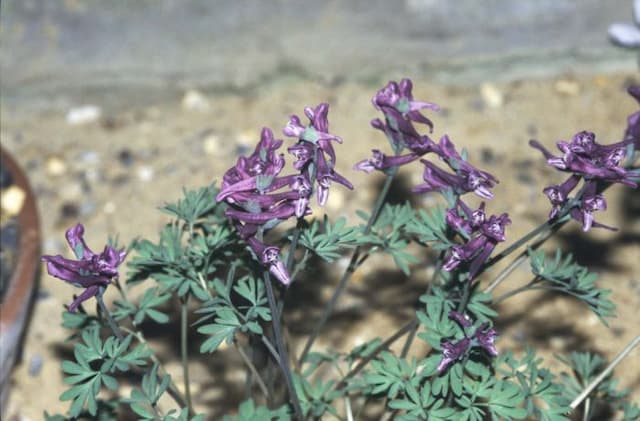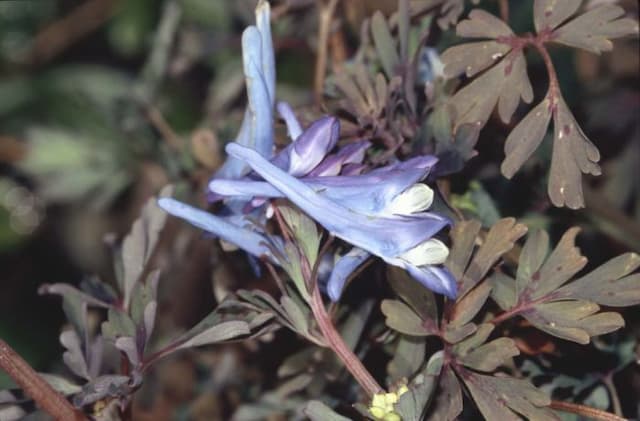Corn poppy Papaver rhoeas 'Cedric Morris'

ABOUT
The 'Cedric Morris' is a variety of the common poppy, known for its distinctive and attractive blooms. The flowers of this poppy are typically a soft, pastel pink, which can vary from a blush to a deeper rosy hue. Each petal is delicate and slightly crumpled in appearance, giving them a relaxed, ruffled look that adds to the plant's overall charm. The petals are arranged in a simple cup shape, radiating around a central, dark black-brown or purple blotch that serves as a striking contrast to the light-colored petals. At the very heart of the flower, there is a cluster of stamens that are a deep, dark purple or black, accentuating the central blotch and adding further contrast and complexity to the bloom. The foliage of the 'Cedric Morris' poppy is a soft green, with leaves that are finely divided and feathery in texture, providing a delicate backdrop for the flowers. When in bloom, these poppies are known for their eye-catching display, as the flowers dance on their stems with the slightest breeze, giving the plant a whimsical and ethereal presence in the garden.
About this plant
 Names
NamesFamily
Papaveraceae.
Synonyms
Common Poppy, Corn Poppy, Field Poppy, Flanders Poppy, Red Poppy.
Common names
Papaver rhoeas 'Cedric Morris'
 Toxicity
ToxicityTo humans
The common name for Papaver rhoeas 'Cedric Morris' is Corn Poppy. Generally, Corn Poppy is not considered highly toxic to humans. However, it does contain alkaloids that can potentially cause harm if ingested in large quantities. Symptoms of ingesting parts of the plant, especially the seeds, may include stomach upset, dizziness, and sedation. As with any plant, individual sensitivities can vary, so it's advisable to avoid consuming parts of it.
To pets
The Corn Poppy holds the same risks for pets as it does for humans. It is not typically regarded as a highly toxic plant, but it does contain compounds that can be harmful in significant amounts. If pets consume parts of the plant, they might experience mild symptoms such as gastrointestinal upset or sedation. It's best to prevent pets from ingesting the plant to avoid potential adverse effects.
 Characteristics
CharacteristicsLife cycle
Annuals
Foliage type
Deciduous
Color of leaves
Green
Flower color
Pink
Height
2 feet (60 cm)
Spread
1 foot (30 cm)
Plant type
Herb
Hardiness zones
8
Native area
Mediterranean
Benefits
 General Benefits
General Benefits- Aesthetic Appeal: Adds a splash of color to gardens with its striking red blooms.
- Attracts Pollinators: Invites beneficial insects like bees and butterflies, supporting pollination.
- Low Maintenance: Easy to grow and requires minimal care once established.
- Drought Tolerance: Once established, has a good resilience to periods of dry weather.
- Self-seeding: Capable of naturally reseeding, which allows for easy propagation.
- Seasonal Interest: Provides a vibrant display of flowers in late spring to early summer.
- Companion Planting: Can be used to beneficially intermingle with vegetables and other garden plants.
 Medical Properties
Medical Properties- Mild sedative: Papaver rhoeas, also known as common poppy or corn poppy, has been traditionally used to promote relaxation and sleep.
- Analgesic: Common poppy may offer relief from pain due to its potential analgesic properties.
- Anti-inflammatory: The plant contains components that may reduce inflammation, though this has not been thoroughly scientifically validated.
- Cough suppressant: Used in folk medicine, common poppy may have properties that can help alleviate coughs.
- Expectorant: Historically, it has been used to assist in clearing mucus from the respiratory tract.
- Soothing agent: The petals, particularly in the form of syrup, may have a soothing effect on the throat.
 Air-purifying Qualities
Air-purifying QualitiesThis plant is not specifically known for air purifying qualities.
 Other Uses
Other Uses- Dye production: The petals of the common poppy can be used to produce a red dye for coloring textiles, inks, and food products.
- Eco-friendly pest control: When interspersed in agricultural fields, they can attract pollinators as well as pest predators, helping to naturally control pest populations.
- Artistic inspiration: The vibrant flowers of the common poppy have often been depicted in art and poetry, symbolizing peace and remembrance.
- Culinary decoration: Although not part of the usual culinary uses, common poppy petals can be crystallized or used fresh as decorative additions to desserts.
- Floral arrangements: The flowers and seed pods can be used in dried floral arrangements for decoration.
- Garden aesthetics: The common poppy is often planted for its ornamental value, enhancing the visual appeal of gardens and landscapes.
- Photography: The striking appearance of the common poppy fields is a popular subject for photographers, particularly around remembrance days.
- Educational tool: The lifecycle and morphology of the common poppy can serve as an educational subject in botany and ecology studies.
- Companion planting: They can be used as companion plants to support biodiversity in gardens and farms.
- Soil improvement: The common poppy can play a role in soil conditioning by breaking up compacted soil with its roots.
Interesting Facts
 Feng Shui
Feng ShuiThe common poppy is not used in Feng Shui practice.
 Zodiac Sign Compitability
Zodiac Sign CompitabilityThe common poppy is not used in astrology practice.
 Plant Symbolism
Plant Symbolism- Remembrance: The most common symbolism of red poppies like Papaver rhoeas is remembrance, particularly in relation to soldiers who have died during wartime. This association is due to the poppies that grew over the battlefields of World War I in Europe.
- Consolation: Poppies can also symbolize consolation for a loss or death, offering solace to those who are grieving.
- Peace: Poppies may represent peace because they grew on battlefields and became a sign of the world's desire for an end to war.
- Sleep, Rest: Because poppies can induce sleep, they are often associated with rest and recovery.
- Beauty and Success: With their vibrant color and delicate petals, poppies can also symbolize beauty and success in various cultures.
 Water
WaterThe Common Poppy should be watered deeply but infrequently to encourage strong root growth. Allow the top inch of soil to dry out before watering again. Typically, this might mean watering once a week during active growth, but always adjust based on the rainfall and temperature, as these factors influence the soil's moisture levels. Be cautious not to over-water, as the Common Poppy does not like soggy soil. Depending on the size of the plant and the weather conditions, a good rule of thumb is around 1 gallon of water every 7-10 days during the growing season.
 Light
LightThe Common Poppy thrives in full sun, which means it requires at least 6 hours of direct sunlight per day. Position it in a spot where it will receive plenty of light throughout the day for optimal flowering. Avoid too much shade, as this can lead to leggy growth and fewer blooms.
 Temperature
TemperatureThe Common Poppy is tolerant of a wide range of temperatures and can survive in temperatures as low as 14 degrees Fahrenheit, though it prefers the milder range. The ideal temperature for the Common Poppy would be between 60 to 77 degrees Fahrenheit, which encourages healthy growth and flowering. It's worth noting that extreme heat above 85 degrees Fahrenheit may stress the plant, especially if combined with high humidity.
 Pruning
PruningPruning the Common Poppy is mainly done to remove spent flowers and encourage a second bloom, as well as to prevent self-seeding if not desired. Deadheading, or the removal of faded flowers, should be performed regularly throughout the blooming season. Additionally, you can cut back the foliage after blooming if it becomes untidy. The best time for general pruning is in the fall after the plant has died back.
 Cleaning
CleaningNot needed
 Soil
SoilThe common poppy, including Papaver rhoeas 'Cedric Morris', thrives in well-draining soil with a neutral to slightly acidic pH of 6.0 to 7.0. A mix of two parts loam, one part compost, and one part coarse sand or perlite will provide the ideal balance of nutrients, aeration, and drainage. Avoid heavy, wet soils as poor drainage can lead to root rot.
 Repotting
RepottingCommon poppies like Papaver rhoeas 'Cedric Morris' are not typically repotted as they are annuals. They complete their life cycle in one growing season and do not require repotting. Instead, sow new seeds annually in a well-prepared soil bed or start indoors before transplanting.
 Humidity & Misting
Humidity & MistingCommon poppies such as Papaver rhoeas 'Cedric Morris' are tolerant of a wide range of humidity conditions and do not require any specific humidity levels. They can thrive in the ambient outdoor humidity in most climates without the need for human intervention.
 Suitable locations
Suitable locationsIndoor
Place in bright light, sow in well-draining soil.
Outdoor
Full sun, sow in well-draining soil after frost.
Hardiness zone
2-9 USDA
 Life cycle
Life cycleThe plant known as common poppy (Papaver rhoeas 'Cedric Morris') begins its life cycle as a seed, which, when sown in fertile, well-drained soil and with adequate sunlight, will germinate. After germination, the seedling emerges and develops its first set of true leaves, eventually establishing a small rosette at the soil surface. As the plant matures, it sends up a flowering stalk and blossoms into vibrant red flowers, which are followed by the formation of seed pods once pollination has occurred. The seed pods dry and release their seeds, completing the reproductive cycle. During the growing season, the common poppy grows rapidly, and it completes its life cycle within one year, as it is an annual plant. After releasing seeds, the parent plant dies, but the seeds ensure the continuation of the species by lying dormant until the next favorable growth season.
 Propogation
PropogationPropogation time
Spring-Early Summer
The most popular method of propagation for Papaver rhoeas 'Cedric Morris', commonly known as the Corn Poppy or Field Poppy, is through seed. These seeds are best sown directly into the garden where they are to flower. The ideal time to sow Corn Poppy seeds is in fall, allowing them to stratify naturally over winter, or in early spring as the ground can be worked. Scatter the tiny seeds on the surface of well-drained soil and press them lightly into the earth. It's important not to cover the seeds with soil, as they require light to germinate. Thinning the seedlings once they've sprouted ensures the remaining plants have enough space to develop fully. In about 12 to 24 inches apart is usually sufficient, which is about 30 to 60 centimeters. Keep the soil moist until germination, which typically occurs within 14 to 28 days.









